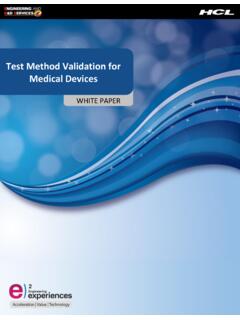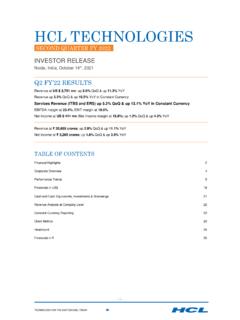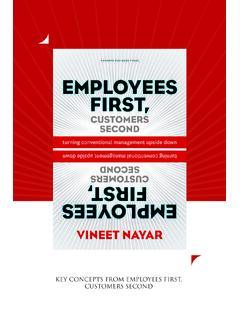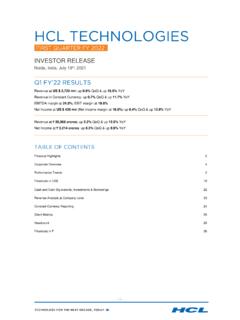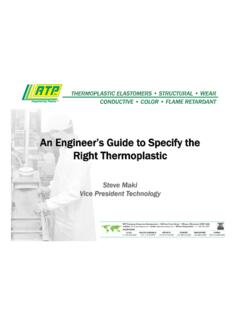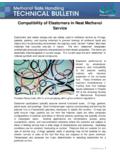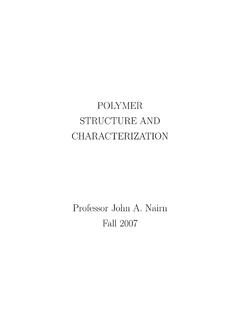Transcription of An Overview of the Plastic Material Selection Process for ...
1 An Overview of the Plastic Material Selection Process for Medical Devices F e b ru a r y 2 0 1 3 An Overview of the Plastic Material Selection Process for Medical Devices | February 2013 2013, HCL Technologies. Reproduction Prohibited. This document is protected under Copyright by the Author, all rights reserved. TABLE OF CONTENTS Abstract .. 3 Abbreviations .. 4 Market Trends/Challenges .. 5 General Guidelines for Material Selection .. 6 Material Selection Flowchart .. 20 Benefits of Pre- Material Selection .. 22 23 References .. 24 Author Info: .. 25 An Overview of the Plastic Material Selection Process for Medical Devices | February 2013 2013, HCL Technologies, Ltd. Reproduction prohibited. This document is protected under copyright by the author. All rights reserved. 3 Abstract The current market trend toward increased safety and quality at a reasonable cost has urged the medical industry to select bio- compatible, clean, and environmentally-friendly materials to meet safety, manufacturability, and functionality requirements for medical products.
2 At the same time, these requirements pose constraints and challenges on the materials selected during product development for medical devices and instruments. Applications in the healthcare industry and medical devices in particular, have some demanding requirements for thermoplastic materials that are unique to this arena. While polymers have been used in the healthcare industry for decades, it has only been in the recent past the designers have started to explore the benefits of using special compounds in medical applications. Metal has been the traditional Material of choice for orthopedic or any surgical instrumentation, but new Plastic resins, combined with scientific Process development and validation, are now making inroads into those markets. Unique technologies related to anti-static, raidopacic, wear-resistant and elastomeric compounds that have made an impact in other industries are just now finding their way into medical devices.
3 This paper presents an Overview of the Plastic Material Selection Process , with specific emphasis on the unique requirements of medical applications. An Overview of the Plastic Material Selection Process for Medical Devices | February 2013 2013, HCL Technologies, Ltd. Reproduction prohibited. This document is protected under copyright by the author. All rights reserved. 4 Abbreviations Sl. No. Acronyms (Polymers) Full Form 1 ABS Acrylobutadiene styrene 2 PP Polypropylene 3 PS Polystyrene 4 PC Polycarbon 5 PSU Polysulfone 6 PPSU Polyphenyl sulfone 7 PMMA Polymethyl methacrylate (Acrylic) 8 PE Polyethylene 9 UHMWPE Ultra high molecular weight polyethylene 10 LDPE Lower density polyethylene 11 PA Polyamide (Nylon) 12 LCP Liquid cystaline polymer 13 PARA Polyaryl amide 14 PPS Polyphenyl sufide 11 PEEK Polyether etherketone 12 PVC Polyvinyl chloride 13 PET Polyethylene terephthalate 14 PTFE Polytetra flouroethylene (Teflon) An Overview of the Plastic Material Selection Process for Medical Devices | February 2013 2013, HCL Technologies, Ltd.
4 Reproduction prohibited. This document is protected under copyright by the author. All rights reserved. 5 Market Trends/Challenges Materials, whether metal or Plastic , have always limited design since man first built shelters, made clothes and undertook human conflict. But right now, materials and the processes to shape them are developing faster than at any time in history; the challenges and opportunities are therefore greater than ever before. This paper is about strategies/guidelines for exploiting Plastic materials for orthopedic instruments and medical devices design. Medical devices and instruments are in a constant state of evolution, responding to trends within and outside the hospital environment to achieve better care at lower system costs. In today s world, as far as medical device design is concerned, safety of human life is the prime objective. The trends toward miniaturization and portability are driving new requirements for housings and drug-coated implants.
5 Cleanliness and sanitation continue to receive strong attention globally, requiring devices to withstand a range of chemicals and sterilization techniques. Reusability of a product was considered as a leap-ahead advantage once, but not any more in the medical industry, especially in orthopedics. The use of single-use instrument is a solution and is the latest trend in orthopedics. This may force the industry to go for Plastic materials by which the cost can be reduced to an extent. But there are still concerns over the desired mechanical properties, biodegradability, sterilizability and radiopacity of the materials used that need to be looked at in detail. An Overview of the Plastic Material Selection Process for Medical Devices | February 2013 2013, HCL Technologies, Ltd. Reproduction prohibited. This document is protected under copyright by the author.
6 All rights reserved. 6 General Guidelines for Material Selection Material Selection is often one of the most intimidating and confusing hurdles encountered by medical device designers. There seem to be hundreds of polymers to choose from, but where do we start? The Material Selection Process requires a preliminary understanding of polymers, additives and their properties. Of primary importance is a basic understanding of polymer morphology and the properties different morphologies bring to the picture. Thoroughly defined application requirements are needed to select appropriate candidate materials. After careful consideration, the possibilities can be narrowed down to two or three candidates, and the final Selection should be determined by testing. It follows the steps below: 1) Translation: Express design requirements as constraints and objectives The following list of queries or considerations should be used to define the application or requirements as much as possible.
7 In many cases the answers to these criteria will be helpful to eliminate a particular Plastic or an entire family of plastics. The more completely the application of medical device/instrument is defined, the better the chance of selecting the best materials for the application. Environmental exposure considerations: Should the Material be biocompatible? Will the component be in contact with body tissues or drugs? If so, for how long? Is the product a single use instrument/device? Will the component undergo sterilization? If so, which method of sterilization will be used? How frequently will it be sterilized? Will any other chemicals/solvent vapours be in contact with the product (wiped/submerged) as part of hospital cleaning? Will the device be painted/electroplated /glued? To what humidity and temperature (maximum and minimum) will the product be exposed? How long will it be exposed? Is dimensional stability in a wet or humid environment critical?
8 What tolerances must be met? Is UV resistance needed? Does the device need to be visible under a fluoroscope or X-ray? Is flame retardability a requirement? Is the colour of the Material is an important factor? Will the part be used outdoors? An Overview of the Plastic Material Selection Process for Medical Devices | February 2013 2013, HCL Technologies, Ltd. Reproduction prohibited. This document is protected under copyright by the author. All rights reserved. 7 Functional and Mechanical Considerations: What are the overall parts dimensions (diameter, length, width, thickness)? Is dimensional stability a factor to be considered? What load will the part have to carry? How long will the load to be applied? Will the load be continuous or intermittent? What is the maximum stress on the part? What kind of stress is it (tensile, flexural, etc.)? Is toughness or impact resistance critical during use?
9 Will the Material be used as a bearing? Will it need to resist wear? What wear or abrasion conditions will the Material see? Is the product going to be used as an electrical insulator? What are the manufacturing processes/options available? If it is a molded component, does it make use of any of these techniques: micro molding, over moulding, insert molding, gas assisted molding or in-mold decoration? What is the target cost of the component? What is the projected life of the part or design? What other mechanical properties are required? Are static dissipation/conductivity/dielectric properties required? Which manufacturing technique is going to be used for producing the final component? 2) Screening: Analyze and follow the guidelines to shorten the Selection Process . The Selection should be based on polymers meeting both the environmental and mechanical/physical requirements.
10 A) One of the first requirements to be considered for medical device polymer Selection is biocompatibility of the polymer Material which comes under environmental exposure consideration. When components are subjected to contact with body tissue/fluids, the components must be biocompatible. Two common biocompatibility test standards are USP class VI and ISO 10993, the latter being more stringent and suited for medical devices. ISO 10993-1 specifies that Process contaminants, residues, and degradation of products should be taken in to account while doing biocompatibility tests. The table below shows biocompatibility test requirements per ISO 10993-1 for different medical products, based on their application. An Overview of the Plastic Material Selection Process for Medical Devices | February 2013 2013, HCL Technologies, Ltd. Reproduction prohibited. This document is protected under copyright by the author.
